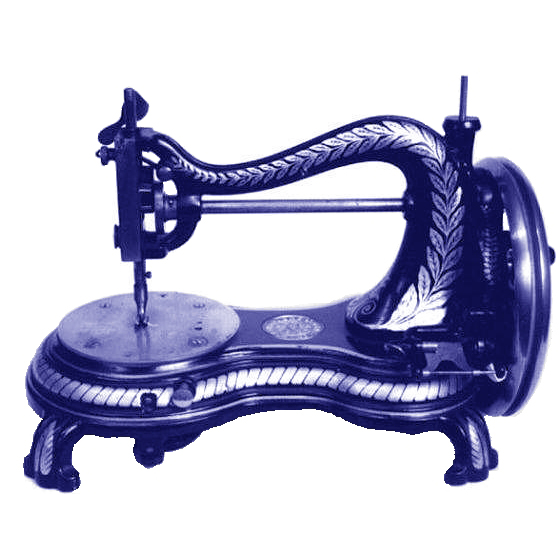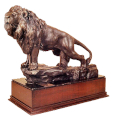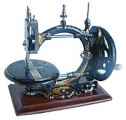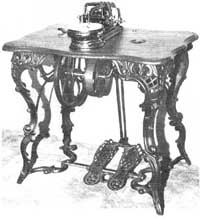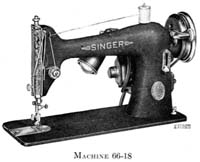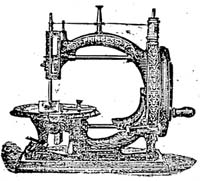Sewing Machines Take on a Life of Their Own
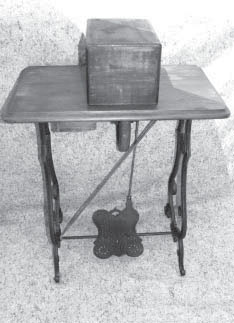
This small drab cabinet houses the rare Williams and Orvis machine
The year is 1975 and someplace in New Hampshire, probably at an onsite auction, an auctioneer is valiantly attempting to obtain a bid on a vintage treadle sewing machine. Embellished with elegant gold on black Egyptian motifs, the machine is pretty enough, but there is no bidding interest and finally the auctioneer quips, "Folks, it would make a great boat anchor." A ripple of laughter in the crowd, and the sewing machine is passed.
Fast forward thirty years and meet Mike Anderson and Wolfegang's Collectibles. Or more precisely, learn about one of Mike's most recent sales, a possible world record. We learned about it in a press release, which read: Mike Anderson of Wolfegang's Collectibles in Brookfield, NH recently sold a rare Williams & Orvis treadle sewing machine to the National Sewing Machine Museum of Australia, (NSMMA) for the sum of $5,870! According to the Encyclopedia of Early American Sewing Machines, Williams & Orvis sewing machines were produced in Boston starting around 1860. About 7,000 were produced in all. The Williams & Orvis machine was a two-thread machine and was produced for home use.
But a little background information is required at this point.
Originally from New Fairfield, CT, Mike was adopted at two months old. He explained, "the only real thing I know about myself and my background, besides the fact that I am Irish and German, is the fact that my birth mother named me Wolfegang. So to honor her and the incredibly hard decision she had to make when I was born, I named my business after the name she gave me, Wolfegang's Collectibles.
"My antiquing background though, comes from my adopted mother. Growing up, our house in CT was an old cape filled with wonderful classic New England furniture, and old collectibles. My mother tells a funny story of me at 5 years old...I was in the basement making a lot of banging noises...when Mom came downstairs to see what I was up to...she found me hitting an old wood chair with a hammer. She asked what I was doing and I replied, I'm making an antique!"
Mike had a very non-tradition, non-antiquing career ahead of him. After graduating from High School in New Fairfield, he attended college at Berklee College of Music in Boston, where he studied Music Business. Dealing in any type of antiques or collectibles was strictly a sideline.
"My full time job was working for a company called Anomaly Records, where I had managed the alternative rock band Sonic Joyride for ten years or so. Sonic Joyride had a song in Billboard's Top 100 called "You'll Never Know" in 1997. When the founder of Sonic Joyride & Anomaly Records, Chris Hobler, was diagnosed with ALS or, Lou Gehrig's Disease in 2000, the band and record company were closed. Chris went on to form a wonderful foundation for ALS research called ALS Hope...(please visit http:/ /www.alshope.org) ...Sadly Chris died from ALS in February of this year (2005). In the meantime, I'd gone on to start Wolfegang's Collectibles."
"I had bought and sold merchandise my whole life, including several classic 60's muscle cars...and over 100 vintage electric guitars, as well as numerous vintage brass, string, and woodwind instruments."
A new career
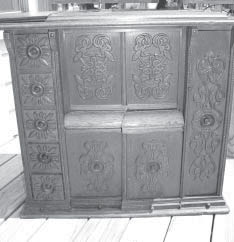
In 1885 this cabinet model was the most expensive option offered by Singer, selling for $200 Today, the
same unit may sell for as much as $2000.
Not only did Singer take trade ins, but offered payment plans, making it possible for the housewife to
afford such a model.
"But, basically after twelve years of working in the music industry, I found myself in the middle of NH, with my wife and kids and my home, thinking...OK, what now? It was time for not only a career change, but a much desired life style change. So the first month that I was unemployed, to make ends meet, I put a few items on eBay. I started by trying to sell the same thing everyone sells...Sterling...Roseville...Fire King... general collectibles...etc. "
"But I soon learned there was a problem. The problem was not getting the merchandise. It was getting it at auction for a fair price, so that I could make money reselling it on eBay. Because everyone seemed to be doing eBay, I found this to be an impossible feat. Sure I could buy the Roseville vase for $150 at auction, but it was only bringing $180 on eBay...hardly a way to make a living!" "So one night I decided to go to the local auction and not buy a thing...but rather just observe, and take notes on what was selling high...and especially what was selling low.
"That night the gentleman that sat right in front of me purchased two Singer sewing machines for $5.00, and I thought...nice machines...and boy that's cheap!"
"So the time came the next week for the same auction, and again, there were two Singer's brought up as a lot...the same gentleman from the previous auction was also present...the auctioneer got down to $5 for both machines again, and the gentleman bid. Only this time I bid two, and I won the machines for $10! The gentleman I bid against turned around and told me that I was crazy to spend that much money on sewing machines! and that I'd never get my money back. Well I put those two Singers on eBay. The first brought $145, and the second brought over $300! Not a bad profit on my initial $10 investment....and my sewing machine career was launched."
"From there, for the next two years I purchased almost every sewing machine that came up at almost every NH auction...purchasing machines that ranged in price from $5 to $2,500."
"Ebay at this time (2003) was a full time job for me. I depended solely on my eBay auctions for my income. I achieved eBay's Powerseller Silver status, and to date have maintained a 100% positive feedback rating with well over 1,100 feedbacks."
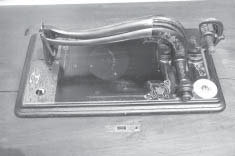
This Grover and Baker with treadle would have a place on many peoples top ten list
"As time progressed during the 2003 year, eBay started to really slow down. The same merchandise that had brought good money the months before was now bringing about 1/2. This was just due to a sluggish economy and the slower summer eBay season. At this point I came up with a clever plan. I decided that I would ask everyone who bought a collectible sewing machine from me, to email me their "wish list" of the top 10 machines that they'd like to own. If I found one of them I would email or call the interested party and sell them the machine directly, as opposed to relying on eBay. Many of my customers, who were fed-up with fighting for machines they wanted on eBay, loved this idea."
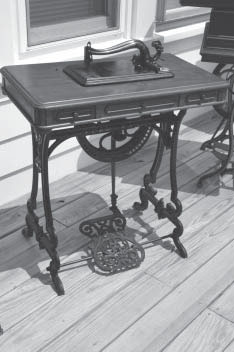
"One by one, I combed the countryside, and began finding these older, more obscure machines that honestly, no-one thought I'd ever find. One gentleman who had given me quite an ambitious list, has since become my good friend, Lee King of South Australia. Lee is the gentleman who is opening the National Sewing Machine Museum of Australia...or the NSMMA for short. More about Lee in a bit."
"I soon found out that finding these machines was only half the battle. I found that sewing machine collectors were very jaded because of eBay, and especially eBay sellers who did not know how to properly pack an antique, cast iron, sewing machine. Each and every one had a shipping horror story to share with me. It typically went like this."
"I paid $1,000 for a rare 1870's sewing machine on eBay...it arrived smashed into a million pieces...the seller simply put the machine in a box and surrounded it with peanuts....I'd like to buy from you Mike, but do you know how to pack an antique sewing machine?"
"I bring up this point, because it's really the packing and shipping that has given me a good reputation and made it possible for me to get high prices for my machines."
"It upset me to the point that I decided I would not sell a machine again until I knew how to properly pack one. So I began to think about supplies....heavy duty supplies. When I looked into how much they were to buy, I nearly fell over! This really disappointed me. These machines needed to be packed well so that I could command high prices. But, the supplies to pack them cost way too much, so what could I do?"
"That very same day my wife and I had the local Sears department store bring us a new refrigerator. When the delivery guys were unpacking the fridge from a huge box, these great hard compressed cardboard corners, as well as these one inch thick cardboard sheets fell out of the box. I asked the delivery guys if I could have the packaging, and then it occurred to me to ask the delivery guys what they did with all of this great heavy-duty packing material everyday? Their response was...we throw it out!"
Recycling
"The very next morning I was in my truck and on my way to the local Sears. I met with the store's manager and explained to him that we could help each other out. He said "how?" I replied, "what would you say if I told you I could save you about 1/2 of your dumpster/garbage disposal fees each year?"
"He obviously was very interested as any good manager would be. I told him that I would pick up packing supplies from him each week to use for my business, saving him hundreds of dollars a year on dumpster fees. His dumpster would fill up half as fast, thus costing him less! My packing supply problem was now solved. If those packing supplies could protect a new fridge, they certainly could protect an old sewing machine. To this day I am still working with my local Sears. It's a great relationship.""He obviously was very interested as any good manager would be. I told him that I would pick up packing supplies from him each week to use for my business, saving him hundreds of dollars a year on dumpster fees. His dumpster would fill up half as fast, thus costing him less! My packing supply problem was now solved. If those packing supplies could protect a new fridge, they certainly could protect an old sewing machine. To this day I am still working with my local Sears. It's a great relationship."
"Again, this was a very critical step in the development of my business, which ultimately gave me a good reputation. Now I could safely pack these old machines. I'm really proud of the fact that I came up with that idea, I strongly believe in recycling... antique dealers are the world's greatest recyclers....so why not be great recyclers with our packing supplies too? I have NEVER purchased a cardboard box. Never!" added Mike.
As for that first machine that arrived damaged, you ask, how could Mike have a 100 per cent positive feedback? "well I got lucky I guess. I pleaded with the woman, and gave her the money back. She took pity on me...and still, even after a disaster like that; she gave me positive feedback because I was honest, and did the right thing."
"To date she has purchased 5 machines from me! I think most people are fair and will give you the benefit of the doubt, as long as you are reasonable...and fair. I tell people nowadays that I pack my items the way I personally would like to receive them."
So, now fast track back to 1975… what has happened in the past thirty years? Why are old sewing machines popular now, what has changed? this editor wondered. Along with wishing I'd bought every sewing machine I saw at $1 and $5 and just put them away.
Why are old sewing machines popular now?
Mike explained, "Yes, there was definitely a time when you could buy machines at auction very cheaply. In fact, most auctioneers either would not remove them from the houses they were cleaning out, and if they did, they simply would not sell at the auction. So what happened?"
"Well, my understanding is that eBay happened. I mean....most of the collectors I now deal with have been collecting machines for years and years. Long before eBay. It's like anything else...if it was made...someone collects it. You have to remember that there were literally 1,000's of different brands of sewing machines made. They were made as early as the late 1850's...and as they got refined, as they worked better, towards the 1870's they began to be lavishly decorated with gold gilt, mother-of-pearl, and hand paintings. As these machines entered into the 1880's and 1890's they were extremely fancy. These are the machines that command great prices nowadays."
"What eBay did that is great, was this...they opened the door to a global marketplace. While giving old-time collectors their first chance ever to purchase machines from Europe...eBay also gave birth to a new group of collectors, who were hungry for what I call the "starter machines." These are the machines that you once would see being given away at auction for next to nothing...the typical Singer Treadles...New Home treadles, White Treadles, Wheeler & Wilson Treadles.
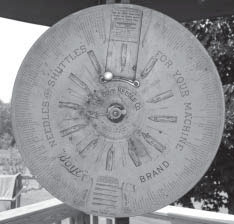
This Boye shuttles and needles tin would have hung in a general store. You twist the dial to the size needle/shuttle you need and slide the door at the top open to retrieve your item. Cabinet mounted models are more desirable and consequently are more expensive.
This hungry group of newly eBay born collectors not only started to drive up the price of these common machines at auction, the eBay dealers who attended these same auctions also started to drive the price up. I believe it was NH auctioneer Gary Wallace who said to me, "you single-handedly changed the value of these machines." What a nice compliment!"
"So nowadays do I buy the common Singer Treadle? Sure. I still have clients who need parts and pieces, or who are just starting to collect."
"Mostly nowadays I buy directly from estates and from a local network of antique dealers who have been very good to me. I think these dealers all chuckled when I told them what I wanted to do, and what I wanted to sell. More than one told me I was crazy and that I would fail. But I am persistent. Around the greater Wakefield, NH area there are four terrific dealers who really took me under their wings and helped me. Lewis Antiques, Meadow Street Antiques, Grant Hill Antiques and Carswell Antiques. I mention these folks because without them, what I do would not have been possible. Through their recommendations and referrals, my business has thrived! All of their shops are world-class fine establishments! I am very grateful for their kindness and generosity."
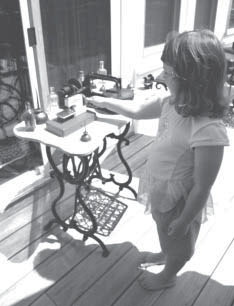
Mike's daughter Gwyn showing off one of the toys
Addicted to buying sewing machines
Mike added, "The Williams & Orvis machine is the highest priced machine that I have sold to date. I have sold many in the $2,000 to $4,000 range. But, I am looking for machines all the time. In fact I think I start to twitch and whir if I don't buy a machine every four days or so! I am addicted! But seriously, I focus mainly on purchasing the uncommon machines now."
"Machines made prior to 1900 are my specialty, and there were thousands of brands made, but can you find them? I also buy any and all hand crank sewing machines. I try to stay away from electric machines, but occasionally I will buy a neat or different one. As a general rule of thumb, if the machine is cast iron, and comes mounted on its own cast iron base. I want it."
"Machines that I will buy in any condition are hand cranks, paw foot machines, cast iron base machines, machines that have a clamp built into them so they can attach to a table, (the clamp being integral, not a separate piece)...and especially toy treadle machines and cast-iron toy hand crank machines. I will always consider buying any full size treadle, but I lean towards treadles that have a wood box that covers the machine, as opposed to a treadle with a machine that drops into the cabinet and hides away."
"My biggest criteria in regards to prices paid is obviously condition. The more of the fancier decoration that remains, the more the machine is worth. Although all machines do have a ceiling in price that they eventually meet. Finding a machine like the Williams & Orvis is quite rare."
"Gary Wallace asked me if I achieved a world record price on the William's & Orvis machine. My answer is...I think so. I only know of two others sold...one for $4,000+ at an auction in Epping, and another from an online supplier that sold for just under $5,000. I don't know for sure though."
Shipping to Australia
This editor was most interested in how Mike sells to folks in Australia, and how he ships these rather heavy machines.
Mike explained, "For the last two years about 35% of my business has been with the great people of Australia. Why they like sewing machines so much is still a mystery to me. But they do like them, and they will buy them and pay great prices, so long as you can prove that you can pack the machines safely for the long trip. Generally speaking I ship abroad using US mail. Everyone else is too expensive. I have filled a 20' container and arranged for freight shipping also...but that is shipping about 30 machines at once."
NSMMA
"This brings us back to the topic of my friend in South Australia, curator of the NSMMA, Lee King. Lee is a fascinating person and is also one of the main reasons I have been successful. Not only has he purchased many machines from me, he has gone out of his way to recommend me to his fellow countrymen, as well as to his closest sewing machine collecting friends around the world. He jokes with me and tells me that the "Anderson" wing of the NSMMA is currently under construction!"
"But Lee King is a great story alone...His main business in Australia is a company that builds and designs hydroponic systems so that people can grow plants in the hot Australia outback. Very smart! Lee has possibly one of the best know sewing machines collections in the world. I am proud to have supplied him with the majority of his American collection, as well as some Canadian and German machines."
"I think people would find it fascinating to view the NSMMA collection online at... National Sewing Machine Museum of Australia www.nsmma.com. (Webmaster's Note: this seems to now be defunct.) It is really quite a sight to see how many different machines there are, and how many this one individual owns. In the future, I believe several contributors will be involved in the process of gathering machines for the museum."
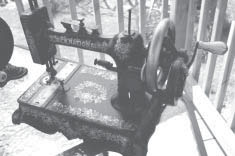
New National on Cast iron base
eBay is just another place to do business
Mike added that these days he sells as little as possible on eBay. "But I do average about 85 listings a month," he added. "I try to focus on private sales. Ebay basically is my outlet for the common machines, parts and small pieces. I use eBay to fill in the financial gaps. Where I once depended on eBay for 100% of my income, now eBay typically accounts for 20% to 30% of what I make each month. Sometimes I will list a rare machine on eBay because I can't pick any one collector to sell it to. And eBay is just fairer...because everyone has an equal shot at it...but this is a rare occurrence. Most of my rare machines get sold directly to my clients."
"Many antique dealers hate eBay. I hear people complain every week that eBay has ruined the industry. While I feel eBay has lowered the price on many items, I look at eBay as just another place to do business. You have your shop or store...your private connections...Antique shows such as Brimfield..and there is eBay. Why would any antique dealer turn down a great place to sell their merchandise, and what a better market could there possibly be that the world-wide market? Ebay's OK in my book."
So, does Mike deal in anything besides sewing machines? Of course! What self-respecting antiques dealer doesn't "dabble" in other stuff.
Mike explained, "Currently my wife and I also deal in vintage radios, phonographs and fine Sterling. This past year we purchased a collection of 250+ sterling collector spoons from a local estate for about $300. We nearly dropped dead when the first spoon we put on eBay brought $330! The rest of the lot was, well... too good....just too good!"
If you have a sewing machine you think Mike might be interested in, you can contact him at Wolfegang's Collectibles, Mike & Kelly Anderson, PO Box 108, Brookfield, NH 03872. (603)522- 9100 or email [email protected]
The above article was originally published in Unravel the Gavel a New Hampshire specialist antiques newspaper.
Reference: The Encyclopedia of Early American Sewing Machines by Carter Bays published by Collector Books
